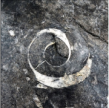Polyplacophorans (chitons)
How to recognise them
Oval shape made of lots of segments.
Fossil Info
Polyplacophorans have a body made of lots of segments. They look like arthropods (the group of animals that includes insects and crabs), but they are in fact molluscs and so they are related to gastropods, e.g. snails and cephalopods e.g., ammonites. The oldest fossil chitons are from the Devonian Period around 400 million years ago but they may have evolved much earlier in the Ordovician Period (around 470 million years ago). They stick to hard surfaces like rocks but can move around. They are still alive today - you can find them in rock pools but they are often very well camouflaged.
Fun Fact
These strange molluscs have a strong homing instinct but scientists are not yet sure how they find their way from feeding spots back to their home scar. They may guide themselves using chemical signals that they leave on the rocks or using the Earth's magnetic field.
Photo: Modern chitons - photo by © Hans Hillewaert, CC BY-SA 4.0, https://commons.wikimedia.org/w/index.php?curid=5674162


